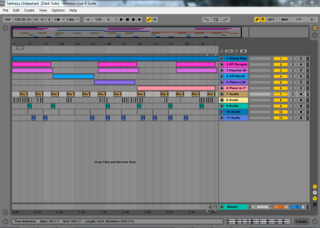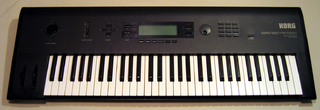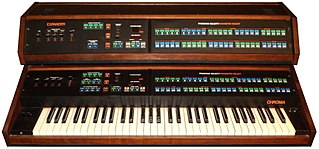
A digital synthesizer is a synthesizer that uses digital signal processing (DSP) techniques to make musical sounds, in contrast to older analog synthesizers, which produce music using analog electronics, and samplers, which play back digital recordings of acoustic, electric, or electronic instruments. Some digital synthesizers emulate analog synthesizers, while others include sampling capability in addition to digital synthesis.

Digital music technology encompasses the use of digital instruments to produce, perform or record music. These instruments vary, including computers, electronic effects units, software, and digital audio equipment. Digital music technology is used in performance, playback, recording, composition, mixing, analysis and editing of music, by professions in all parts of the music industry.

The MOS Technology 6581/8580 SID is the built-in programmable sound generator chip of the Commodore CBM-II, Commodore 64, Commodore 128, and MAX Machine home computers.

CV/gate is an analog method of controlling synthesizers, drum machines, and similar equipment with external sequencers. The control voltage typically controls pitch and the gate signal controls note on-off.

A sampler is an electronic musical instrument that records and plays back samples. Samples may comprise elements such as rhythm, melody, speech, sound effects or longer portions of music.

Novation Digital Music Systems Ltd. is a British musical equipment manufacturer, founded in 1992 by Ian Jannaway and Mark Thompson as Novation Electronic Music Systems. Today the company specializes in MIDI controllers with and without keyboards, both analog and virtual analog performance synthesizers, grid-based performance controllers, and audio interfaces. At present, Novation products are primarily manufactured in China.

Ableton Live is a digital audio workstation for macOS and Windows developed by the German company Ableton.

A sound module is an electronic musical instrument without a human-playable interface such as a piano-style musical keyboard. Sound modules have to be operated using an externally connected device, which is often a MIDI controller, of which the most common type is the musical keyboard. Another common way of controlling a sound module is through a sequencer, which is computer hardware or software designed to record and playback control information for sound-generating hardware. Connections between sound modules, controllers, and sequencers are generally made with MIDI, which is a standardized interface designed for this purpose.

The ARP Odyssey is an analog synthesizer introduced by ARP Instruments in 1972.

The Roland MC-202 (MicroComposer) is a monophonic analog synthesizer and music sequencer released by Roland in 1983. It was the first groovebox. Its synth is similar to the TB-303 bass synth and the SH-101 synthesizer, featuring one voltage-controlled oscillator with simultaneous saw and square/pulse-width waveforms. It is a successor to the Microcomposer family of sequencers, including the MC-8 and MC-4. The unit is portable and can be operated from batteries or an external power supply.

Waldorf Music is a German synthesizer company. They are best known for the Microwave wavetable synthesizer and Blofeld virtual analogue synthesizer.
Arturia is a French electronics company founded in 1999 and based in Grenoble, France. The company designs and manufactures audio interfaces and electronic musical instruments, including software synthesizers, drum machines, analog synthesizers, digital synthesizers, MIDI controllers, sequencers, and mobile apps.
Synapse Audio Software is a software company located in Germany. Previously known as Sonic Syndicate and headed by Richard Hoffmann, they develop music production software for the Mac OS and Microsoft Windows platforms. They started developing software in November 1998 as Sonic Syndicate and changed their name to Synapse Audio with the release of Orion Platinum in 2002.

The Korg Wavestation is a vector synthesis synthesizer first produced in the early 1990s and later re-released as a software synthesizer in 2004. Its primary innovation was Wave Sequencing, a method of multi-timbral sound generation in which different PCM waveform data are played successively, resulting in continuously evolving sounds. The Wavestation's "Advanced Vector Synthesis" sound architecture resembled early vector synths such as the Sequential Circuits Prophet VS.

The Elektron Monomachine is a synthesizer and music sequencer by Elektron. The Monomachine was available as SFX-60 model, which is a desktop sound module, and was available as the SFX-6 model, which has a keyboard and a joystick controller. During the last quarter of 2007 Elektron released the SFX-60 MkII, which is a revision providing higher signal-to-noise ratio, a slimmer design and the ability to add user waveforms, introduced with OS 1.20 in July 2008.

A synthesizer is an electronic musical instrument that generates audio signals. Synthesizers typically create sounds by generating waveforms through methods including subtractive synthesis, additive synthesis and frequency modulation synthesis. These sounds may be altered by components such as filters, which cut or boost frequencies; envelopes, which control articulation, or how notes begin and end; and low-frequency oscillators, which modulate parameters such as pitch, volume, or filter characteristics affecting timbre. Synthesizers are typically played with keyboards or controlled by sequencers, software or other instruments, and may be synchronized to other equipment via MIDI.

The Evolver is an analog-digital hybrid synthesizer designed by Dave Smith and manufactured by Dave Smith Instruments. It was first released as a desktop version in 2002, then later a 37-key keyboard bearing the same synth engine as the Evolver desktop was also released. A polyphonic version of the Evolver, dubbed the Poly Evolver, was released in 2004 as a rackmount version, then a 61-key keyboard version of the Poly Evolver was released in 2005. The Evolvers were replaced by new high end models, the Prophet 12 and the Pro 2.

The Rhodes Chroma, initially the ARP Chroma, is a polyphonic, multitimbral, microprocessor controlled, subtractive synthesis analog synthesizer developed in 1979-1980 by ARP Instruments, Inc. just before the company's bankruptcy and collapse in 1981. The design was purchased by CBS Musical Instruments and put into production by their Rhodes Division in 1982 as the Rhodes Chroma, at a list price of US $5295. Rhodes also released a keyboard-less version of the Chroma called the Chroma Expander at a list price of US $3150.

The CZ series is a family of low-cost phase distortion synthesizers produced by Casio beginning in 1985. Eight models of CZ synthesizers were released: the CZ-101, CZ-230S, CZ-1000, CZ-2000S, CZ-2600S, CZ-3000, CZ-5000, and the CZ-1. Additionally, the home-keyboard model CT-6500 used 48 phase distortion presets. The CZ series was priced affordably while having professional features. In the same year Yamaha released their low-cost FM synthesizers, including the DX-21 and Yamaha DX100 which cost nearly twice as much.

























